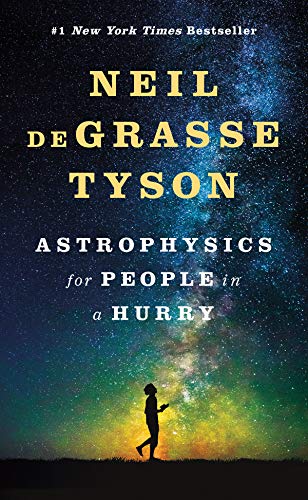
About
Title: Astrophysics for People in a Hurry Authors: Neil deGrasse Tyson Category:supplementals Number of Highlights: 20 Date: 2022-07-17 Last Highlighted: **
Highlights
The most accurate measurements to date reveal dark energy as the most prominent thing in town, currently responsible for 68 percent of all the mass-energy in the universe; dark matter comprises 27 percent, with regular matter comprising a mere 5 percent.
Ordinary matter is what we are all made of. It has gravity and interacts with light. Dark matter is a mysterious substance that has gravity but does not interact with light in any known way. Dark energy is a mysterious pressure in the vacuum of space that acts in the opposite direction of gravity, forcing the universe to expand faster than it otherwise would.
People who believe they are ignorant of nothing have neither looked for, nor stumbled upon, the boundary between what is known and unknown in the universe.
Science is not just about seeing, it’s about measuring, preferably with something that’s not your own eyes, which are inextricably conjoined with the baggage of your brain. That baggage is more often than not a satchel of preconceived ideas, post-conceived notions, and outright bias.
But high-mass stars fortuitously explode, scattering their chemically enriched guts throughout the galaxy. After nine billion years of such enrichment, in an undistinguished part of the universe (the outskirts of the Virgo Supercluster) in an undistinguished galaxy (the Milky Way) in an undistinguished region (the Orion Arm), an undistinguished star (the Sun) was born.
We are stardust brought to life, then empowered by the universe to figure itself out—and we have only just begun.
The universe is under no obligation to make sense to you.
In other words, after the laws of physics, everything else is opinion.
Without the billion-and-one to a billion imbalance between matter and antimatter, all mass in the universe would have self-annihilated, leaving a cosmos made of photons and nothing else—the ultimate let-there-be-light scenario.
Every second of every day, 4.5 billion tons of fast-moving hydrogen nuclei are turned into energy as they slam together to make helium within the fifteen-million-degree core of the Sun.
Nebulium was simply the signature of ordinary oxygen doing extraordinary things.
Only three of the naturally occurring elements were manufactured in the big bang. The rest were forged in the high-temperature hearts and explosive remains of dying stars, enabling subsequent generations of star systems to incorporate this enrichment, forming planets and, in our case, people.
Tags:physics
Filling out the entire electromagnetic spectrum, in order of low-energy and low-frequency to high-energy and high-frequency, we have: radio waves, microwaves, infrared, ROYGBIV, ultraviolet, X-rays, and gamma rays.
Time to get cosmic. There are more stars in the universe than grains of sand on any beach, more stars than seconds have passed since Earth formed, more stars than words and sounds ever uttered by all the humans who ever lived.
Shortly before, during, and after the strong and electroweak forces parted company, the universe was a seething soup of quarks, leptons, and their antimatter siblings, along with bosons, the particles that enable their interactions.
Another class of universal truths is the conservation laws, where the amount of some measured quantity remains unchanged no matter what. The three most important are the conservation of mass and energy, the conservation of linear and angular momentum, and the conservation of electric charge. These laws are in evidence on Earth, and everywhere we have thought to look—from the domain of particle physics to the large-scale structure of the universe.
We do not simply live in this universe. The universe lives within us.
Tags:physics
Later still, the electroweak force split into the electromagnetic and the “weak nuclear” forces, laying bare the four distinct forces we have come to know and love: with the weak force controlling radioactive decay, the strong force binding the atomic nucleus, the electromagnetic force binding molecules, and gravity binding bulk matter.